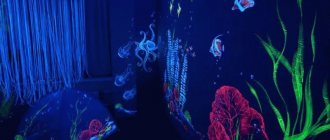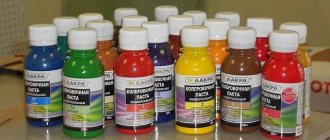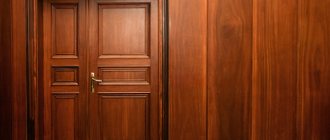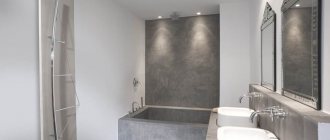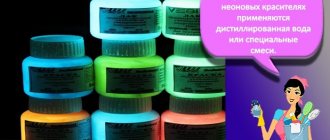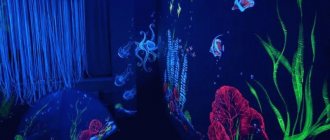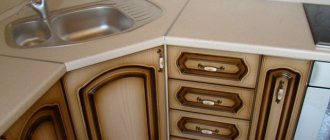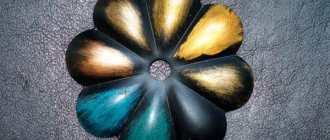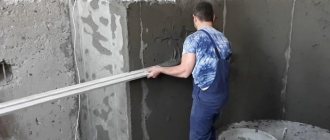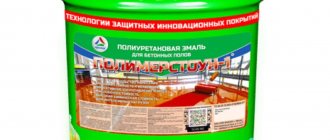The era of dull and gray concrete products is over. Modern technologies make it possible to give building materials any colors and shades.
This can be done using pigments. Colored concrete is widely used in the creation of paving slabs, paving stones, side stones, curbs, stairs, decorative sculptures, etc. The popularity of colored compounds in the construction and renovation of houses is growing every year.
Pigments for concrete can be added to the solution during mixing or applied to the surface of the structure after the composition has hardened.
Substances that give color to a structure can be of natural or synthetic origin. The color saturation depends on the chemical composition of the pigment. For example, red color is achieved using red iron oxide, white - titanium dioxide. Mineral coloring additives include chromium oxide, red lead, manganese, etc.
Mixing colored concrete
To ensure uniform distribution of color throughout the entire structure, it is best to add dye at the stage of mixing the solution. Even if after some time the top layer is erased in some places, the product will not lose its attractive appearance.
The degree of color saturation directly depends on the amount of dye that you add to the composition. However, the cost of such pigments is quite high. Therefore, the price of colored concrete is higher than traditional concrete.
It’s not difficult to make such a colored solution with your own hands, the main thing is to strictly follow the proportions:
- 1 part cement; 2.5 parts sand; 4 parts fine gravel; 1.4 parts water; dye.
You can achieve the maximum effect if you take white sand and white cement. In this case, you will be able to get a beautiful shade even with a minimum pigment content.
Before adding the coloring agent to the mixture, it should be diluted in a small amount of water. Pour the resulting mixture into the solution gradually, stirring continuously. The homogeneity of the solution directly depends on the quality of mixing.
If you want to save on dye, fill the area to 2/3 of the depth with simple cement mortar, and place a layer of colored mortar on top.
Painting concrete base using etching method
If you decide not to overpay and want to make a concrete dye yourself, you can start by creating a perchloric acid dye. It does not allow moisture to pass through, but at the same time provides air access. Compared to other acid dyes, perchloric acid pigment is 1.5 times more durable.
To create chlorine paint you will need:
- 0.24 liters of calcium chloride; 0.5 kg of dry lime paint of the desired color; 1.1 liters of fluff lime; 7 liters of water; 25-30 g of laundry soap per 1 bucket of paint.
Stir fluffed lime in 5 liters of water. Grind the lime paint in a small volume of water and bring it to 1 liter.
Add calcium chloride to this composition. Separately, dissolve soap shavings in a small amount of warm water. Pour all this into the previously prepared composition and filter through a layer of gauze.
Clean the surface from dust and degrease it with a solvent. Painting the concrete base is carried out with a roller or brush in 1-2 layers, after which we give 6 hours for the chemical reaction to occur.
Then rinse the surface with a stream of cold water and dry it with a soft sponge. After complete drying, check the brightness of the color and, if necessary, apply another layer. When working, you should use protective equipment (rubber gloves and goggles). Water-based acid dyes react with calcium dioxide in concrete, resulting in the creation of complex, insoluble colored compounds. Using this homemade dye, you can not only give concrete the desired shade, but also protect it from moisture. Just recently, my wife and I were lucky enough to purchase own an old house in one of the nearby villages.
I will say that this house was not anything good, since it needed to be rebuilt practically from scratch. Probably the only thing that suited us about it was that there was a magnificent grape and apple orchard, and several acres of land for a vegetable garden. In order for our new house to look great, we decided that we would start with the foundation, but make it an unusual gray and multi-colored. There are a lot of articles on the Internet about how to paint concrete, and after reading a little, I decided to try making a dye for do-it-yourself concrete. I’ll get ahead of myself and say that at the same time we learned the basics of preparing concrete in a concrete mixer.
Process of painting concrete after curing
Many developers who have not encountered painting concrete are interested in how to paint the cement mortar after it has set, dried and acquired the required hardness?
There is also a water-based liquid acid dye for sale for concrete mixtures, often used for private repairs.
This possibility exists and is used to cover ready-made, monolithic structures made of ordinary and reinforced concrete. The method is the process of applying a layer of paint to the surface of the finished product. A special composition must be used that penetrates deeply into the pores of the concrete surface. The composition forms a coating on the concrete product and penetrates into the concrete mass by more than 5 mm.
The technology has proven itself positively when painting large areas and performing facade work. The preservation of the color of a concrete product is determined by the ability of the substance to penetrate deeply into the base and its hydrophobicity (moisture resistance) after hardening.
With increasing depth of penetration of the composition containing pigment dye, the service life and color saturation of the surface increases. After all, the top layer will be under the influence of natural factors that have a detrimental effect on most coloring compositions.
The ability to resist abrasion is an important point. As the top layer wears, the paint will be removed. That is why manufacturers of paving slabs paint the cement mixture, and not the finished product.
How to make a dye for concrete with your own hands
First, there are two ways to paint concrete.
This is the usual painting after drying, and coloring the concrete while working. I decided to try both ways. I decided to paint the foundation and blind area during mixing, and the path to the garden after the concrete had completely dried.
And so, when I started building a house, before pouring the foundation, I bought some things to paint. This is not a cheap way, but in the future, I won’t have to spend money on paint for constant touch-ups.
My wife and I went to the store to choose a color and dye for concrete. Upon arrival, I learned a lot about painting concrete. Firstly, concrete can be colored with several dyes, and secondly, they differ from each other.
Is color solution really necessary?
Until a certain point, only the standard gray color of masonry mortar was used in construction. In some cases, it disrupts the picture and spoils the appearance of the facing brick being laid. Another unpleasant effect of ordinary mortar may be the appearance of efflorescence on the brick due to exposure to moisture during laying. After complete drying, the shade may change the masonry seam itself, which does not look as intended. Some types of facing bricks can absorb moisture from cement, which gives bright shades a grayish color. The gray tint is also given by the fact that the total area of the seam can occupy up to 15% of the total area to be laid. This is a significant indicator that makes adjustments to the color palette. Along with the seam, dust that constantly settles on the surface can spoil the appearance.
There are several ways to solve the problem of fading of facing bricks. Experienced craftsmen use the following tricks:
- use of grout;
- painting;
- colored solution.
Grouting the joints of tiles or other tiles is common. At the same time, a shade is selected that best suits the laid tiles. Some craftsmen do the same for facing bricks. A special grouting compound is selected that gives the seams an attractive appearance. The procedure takes some time. The other option is not so scrupulous, but the material consumption will also be significant. A special coloring composition is selected and applied to the entire surface of the wall.
At the same time, the seams change their color, the shade of the brick stands out to a greater extent and the material acquires an additional water-repellent effect. This reduces the likelihood of efflorescence. The last method is to prepare masonry mortar of a suitable color. This method is the most effective, since there is no need for periodic maintenance of the seam. The color lasts for a long time.
Note! There are five pigments in total, which are basic for obtaining the required shade of the solution. But this does not mean that you should limit yourself to this. With the right ratio, you can get up to 30 different shades that will suit any masonry.
The correct selection of a color shade for a specific type of facing brick not only improves the appearance, but also makes it possible to create a different look depending on the time of day. The length of the sun's rays can be different, so the building will play with tints or shade a specific color, which looks unusual and solid. There are several main ways in which a brick joint can be distinguished:
- underlining;
- contrast;
- merger.
The first method allows you to emphasize the shade of the brick, as intended by the architect. In this case, the shade of the joint may be slightly darker and duller than the brick, which will allow the blocks to play in all shades. Contrasting pigment allows you to create a unique combination based on opposition. In this case, it is important to use colors that can be combined in the palette, but have different shades. The last type of pigment selection makes it possible to create a single-color plane. In this case, the seam practically does not stand out against the background of the brick.
Types of dyes
The store salesperson said that they have several types of dyes on sale.
The first of them was acidic. We're told this is one of the most popular methods of staining concrete today. The dye is an absolutely harmless powder, which, when mixed with concrete, acquires the required color
The next option we were offered was acrylic paint.
This is a fairly cheap option for painting walls, but not the worst. Acrylic paint has very good properties. It doesn't fade for a very long time and holds the color well.
There are a huge variety of color options, allowing you to choose the color you want. And the main advantage for me was that I didn’t have to figure out how much dye to add to the solution.
Dyes quality
Paints used for coloring solutions must have certain quality indicators:
- they must have a high degree of dispersion. The smaller the particles in the pigment, the easier it is to work with the mass, it becomes rich and homogeneous;
- good hiding power. The composition should well cover the natural color of the solution;
- resist the alkaline environment in solution;
- oil holding capacity – the ability to hold the oily fraction on top. The lower its value, the lower the pigment consumption;
- immunity to ultraviolet rays. Natural pigments have more durable characteristics; synthetic pigments discolor faster;
- affordable prices.
The most common additive for the solution is iron oxide pigments. They hardly fade and have a rich color. Various types of tiles, tiles, and concrete rings are made from them.
Simple option
We were also suggested to use simple dyes for concrete with our own hands. They, like acidic ones, have a powdery appearance. The advantage of such dyes is that they are easy to mix and have a large number of colors.
When buying such a dye, we would have to be very careful in our choice, since if we buy poor quality paint, we can constantly tint certain places in the future. Because such material quickly fades in sunlight, and is very weak to natural disasters.
Dry dyes
There are also dry dyes.
This type of concrete painting did not seem too simple to me, because it is applied to fresh concrete with a trowel, in a relatively thin layer. But on the other hand, this type of coloring has a huge number of shades. The color does not fade and is resistant to weather changes.
And one last thing. What the consultant suggested to us were color additives. As he told us, they can be in either liquid or powder form.
It must be added to wet concrete. This contributes to the complete coloring of the concrete; they can also be called concrete pigments. This ensures that concrete does not fade over time and withstands all weather conditions very well.
So, after weighing all the pros and cons, I decided that I would use acrylic paint to paint the gazebo and the foundation under it, I decided to paint the path from the house to the gazebo with an acid dye, since it would look like tiles.
And when painting the foundation of the house and the concrete blind area poured with my own hands, I decided to use colored dyes. After the construction was completed, I got what I needed.
And the video will show a complete overview of all the dyes that you can use.
Architectural and construction design, as a way to implement conceived ideas, has recently become the norm, accessible to any average person. At the same time, achieving the goal is carried out with the help of new construction technologies. One of such popular construction solutions of modern technologies is colored concrete, which, in combination with surface structuring, gives an unsurpassed result.
DIY concrete dye
This method of decoration is used today in all types of concrete products, from paving slabs to concrete sculptures. It should also be noted that this area is rapidly developing, which significantly affects the durability of dyes and its positive impact on the quality of concrete.
It should also be noted that dyes for concrete are generally produced industrially, but folk dyeing methods create their own technologies based on the chemistry of substances used in construction.
Colorants for concrete mixtures are usually added during mixing and can also be used as a painting material on the surface of the finished product.
Such dyes can be natural in nature (mineral: chromium oxide, manganese, etc.), as well as synthetic. For example, iron oxide produces a red color, while titanium dioxide produces a white color.
Using dye in concrete mix
Adding dye to the concrete mixture gives a more reliable and durable result due to the depth of penetration. Also, even if over time the top layer of concrete is rubbed and worn out, its color structure does not change.
Adding dye to concrete mixture
At the same time, experts note that the cost of such concrete increases significantly with the cost of coloring substances.
It is this method that is most often used for the manufacture of decorative paving slabs, as well as elements for arranging open areas of the home.
This method is also very effective when using concrete mixture for pouring large surfaces (platforms, driveways, paths, etc.). After all, over time, their decorative layer does not change; they do not need to be tinted or the decorative layer restored.
Color depth is achieved by using the calculated ratio of the amount of concrete mixture to the amount of dye. Changing the concentration allows you to get several shades of the same color
Methods for coloring cement mortar
How is the working mixture painted? The process of obtaining colored concrete is more preferable. It allows for uniform painting of the entire array, ensuring the preservation of the color scheme even with significant wear of the surface layer.
Used in the industrial production of concrete products (colored concrete tiles and tiles, facade and interior finishing materials)
Color depth is achieved by introducing a significant amount of pigment, which is expensive. Using this method, you will forget about the need to update the cement surface for a long period.
The technological process of giving the cement mortar the required color is carried out in the following ways:
- one specific pigment is added to a cement-based composition intended for pouring a floor or making products;
- compositions of different color shades are poured into the mold. The method is used for single production of concrete products with decorative properties;
- various additives with shades of the same color range are mixed in the general mixture in low concentration, which makes it possible to provide the texture of the stone with veins;
- coating the pouring mold before filling with mortar.
Penetrating painting of concrete surfaces
This method of painting concrete products is no different from the usual procedure for painting products. However, it should be noted that the structure of concrete, when hardened, retains its moisture absorption properties. And this feature is used for additional protection of the concrete surface and for its coloring.
Sample of painted concrete
Essentially, concrete painting uses deep penetrating bases that penetrate up to 5 millimeters into the concrete. In this case, the concentrated coloring of the penetrating base after application changes the color of the top layer of concrete for many years.
This method of painting is very similar to painting wooden products with impregnations, however, water-based impregnations are not entirely suitable for concrete structures due to the insignificant level of penetration and possible leaching over time.
For this reason, you should carefully select penetrating bases, which can be specially designed for this purpose; you can also use varnishes, impregnations for concrete and bases for preparing paint mixtures as a basis.
The main indicator of the base is the depth of penetration of the impregnation into the surface layer of concrete, as well as the level of its leaching and color change under the influence of the environment in the form of rain, snow, ice, wind and sun.
For this reason, experts recommend using this method of painting concrete products in places with low operational load.
Preparation of concrete mixture with dye
Ensuring uniform and deep coloring of the product is achieved by adding dye to the concrete mixture. Moreover, it should be added precisely at the stage of its preparation.
Experts also recommend distributing the coloring matter evenly over the base, which can significantly reduce the final time for preparing the colored concrete mixture. The more carefully this procedure is performed, the faster the final result.
An indicator of the readiness of the mixture is the presence of a uniform color, regardless of where the solution is taken to assess the level of coloring. Compliance with the proportions will ensure that the concrete mixture is prepared with the same level of coloring from batch to batch. At the same time, the irrational use of dyes can not only change the final color of the concrete mixture, but also significantly increase the costs of its preparation, because such dyes are quite expensive.
Also, as practice shows, the quality of a concrete mixture depends on compliance with the proportions of the constituent components of the final mixture:
- - 1 measure of cement; - 2.5 measures of sand; - 4 measures of gravel (fine); - 1.4 measures of water; - measure of dye (by volume of the mixture).
The maximum color effect when using coloring agents in a concrete mixture is achieved if white sand and/or cement is used for its preparation. This reduces the amount of dye used to obtain the desired shade. Also, to speed up the preparation time of the mixture and obtain a uniform distribution of the coloring matter, the dye should be diluted in water before adding to the concrete mixture and added to it in the state of a liquid solution.
Another little secret from practitioners for saving money to create colored concrete. You can first fill 2/3 of the volume of the product or area, and top it up with a 1/3 layer of colored concrete.
Types of dyes for cement
All pigments for cement structures are divided into the following types: dry, semi-liquid and liquid. Mostly dry colors are used, which are mixed with a solution, but they do not react with liquid. Such pigments are resistant to humidity, washing off, and fading.
Dyes can be organic or mineral based, and they can be artificial or natural, depending on their origin. The most famous are natural pigments; they are processed mechanically. Mineral raw materials, that is, ocher or umber, are processed thermally.
Painting the surface of concrete products
Save personal money and make beautiful colored concrete using the method of painting it yourself using a chlorine-based dye.
Paint for concrete floors
This base provides resistance to moisture penetration and also maintains the necessary porosity when exposed to air.
Also, such a base has several times longer service life.
Of course, you can use ready-made paints, but you can also make your own.
The creation of perchloric acid dye is carried out in accordance with the proportions:
- - 0.25 liters of calcium chloride; - 0.5 kg of colored dry paint (lime); - 7 liters of water; - 1.1-1.2 fluff lime; - 20-30 grams of laundry soap per 10 liters of paint.
We dilute fluffed lime in 5 liters of water. Stir dry paint in a small volume of water, gradually adding water, bringing its total volume to 1 liter.
Calcium chloride is added to the resulting mixture. In another bowl, make a soap solution in warm water. After this, mix the prepared solutions and pass them through a gauze filter so that the final composition does not have grains or lumps.
Concrete coloring process
To carry out painting work on concrete, it is necessary to first clean it of dirt and dust, and also degrease it.
Concrete is painted with a sprayer, roller or paint brush in one or two layers, allowing each layer to dry for at least 6 hours. During this time, the necessary chemical reaction of the layers takes place in the top layer of concrete.
To complete the drying process, the painted surface is washed with cold water and dried with a sponge. Complete drying of the surface displays the actual color shade, which can be made more saturated by repeating the surface painting procedure.
The essence of the painting process is the passage of chemical reactions of paint components in combination with concrete components. For this reason, you should adhere to personal safety rules and use protective equipment (gloves, overalls and goggles).
This method of painting not only solves design problems, but is also an additional way to protect concrete from moisture penetration.
Making your own dye
How to paint a concrete product to preserve the breathability of the base and, at the same time, make it difficult for destructive moisture to penetrate. You can buy ready-made chloride-based paint for concrete products, or mix the following components yourself:
- Process water in a volume of 7 liters.
- Dry lime pigment in the amount of 500 grams.
Like any other concrete, colored mortar will turn yellow over time.
- Hydrated lime – up to 1.5 liters.
- Calcium chloride – 250 grams.
- Regular laundry soap - 0.03 kg.
It is necessary to quench the lime in half a bucket of water and, using 1 liter of the composition, dilute the dye. Using the second liter of slaked lime, prepare a solution of laundry soap. Mix them in a common container and strain the resulting dye from undissolved particles.
The dye is a liquid that flows easily down a vertical surface and does not come into contact well with the porous surface of the cement. The problem is easily solved by using an acid-based gel additive.
How to prepare acid dye for cement? Prepare the following ingredients:
- adhesive base;
- special coloring additive;
- solvent;
- additional substances, the introduction of which helps to consolidate the result.
Mix the components until a homogeneous consistency is obtained. Add dye with the chosen pigment. When painting with acid dyes, use safety glasses, work clothes and rubber gloves.
Possibility of obtaining various shades and colors by proportionally mixing basic shades and additives
Video - concrete painting technology
Today, colored concrete is actively used not only in residential but also in industrial construction. Dyes used in concreting perform both decorative and practical functions, namely, they improve the quality of the finished monolith.
Concrete staining has become especially popular among private developers who want to make their country houses and plots more attractive. Therefore, many craftsmen are interested in how to make concrete dye with their own hands. The answer to this and other questions regarding concrete pigments can be found in this article.
Dyes: features and varieties
Concrete dyes (pigments) are compositions with a coloring carrier added to the solution to make it colored. If a high-quality dye is used in the work, then even harsh weather conditions will not be able to affect the shade of the monolith. When the concrete matures, the pigment cannot be removed.
There are three main types of pigments:
- Organic dyes (pigments of yellow, green, blue and brown); Metal dyes (aluminum powder, golden bronze); Mineral pigments, which in turn can be divided into artificial dyes (azure, chromium oxide) and natural (chalk, lime , graphite).
There is another classification in which dyes are divided by composition. Pigments are:
- Acrylic; Acid; Color additives; Dry.
Pigments for concrete are available in the form of:
- Pastes; Powders; Capsules; Emulsions.
Often, resourceful builders make their own concrete dyes. Often, homemade pigments come in paste and emulsion forms.
Colored additives in cement
All color additives are divided into three main categories: liquid, semi-liquid and dry colors. When choosing a category option, you should take into account the operating conditions of the products.
The most optimal type of dye for all operating conditions is powdered (dry) color, which perfectly colors the structure, does not fade under the influence of ultraviolet rays of the sun, is not washed out by precipitation and does not react chemically with the sealer (water).
Dry material for coloring concrete can be of either natural or artificial origin. In both cases, the colors are a composition of fine powders of various metal oxides.
The difference is that natural dyes are obtained by grinding raw materials mined by the ore method, and in the second, the raw materials are waste and by-products of the metallurgical industry.
Widely used standard color colors:
- Black (soot or black iron oxide).
- White (titanium dioxide).
- Red (pure iron oxide).
- Brown (a mixture of red and black iron oxides or umber).
- Yellow (iron oxide hydrate).
- Green (chromium oxide).
- Blue (copper phthalocyanine).
Retail chains offer a huge selection of coloring companies that can be used to produce colored concrete mortar of various shades. In this article, we will introduce clean people to the most popular brands:
- "BAYFERROX" , manufactured by Company LanXESS (Germany). The dyes of this brand are leaders in all respects, have excellent wear resistance, are characterized by the absence of dust fractions, and also contain special substances (dispersants) that ensure the most uniform coloring of the structure. Disadvantages include high cost.
- "Yaroslavsky Pigment" (Russian Federation). The company produces pigments in a wide range of colors: red, brown, orange, green, white, black, blue. At the same time, Yaroslavl Pigment colors are distinguished by their affordable cost, environmental friendliness, resistance to harmful factors (ultraviolet radiation, alkalis, high temperature, atmospheric exposure), excellent hiding power and coloring ability.
- "PRECOLOR AS" (Czech Republic). The company offers an unlimited range of colors. At the same time, PRECOLOR AS pigments are colorfast, environmentally safe for people and animals and meet European quality standards.
- CATHAY Pigments Group (Hong Kong, China). The colors of this brand have excellent coverage, resistance to harmful factors and color saturation.
Painting methods
Coloring concrete mortar can be done using two methods:
- At the stage of preparing the mixture; After the concrete has hardened.
The first method is considered more appropriate, since concrete painted during manufacture has a longer service life. In addition, the paint layer does not have to be refreshed periodically.
The process of painting concrete using the second method is similar to the procedure for painting the walls of a building. However, it is worth remembering that in your work it is necessary to use pigments that can penetrate deep into the monolith (at least 2 mm). If you ignore this requirement, the quality characteristics of the dye will significantly decrease.
Cons and pros
The only, but very significant, disadvantage is the cost of the pigment. Considering that high-quality painting requires a significant amount of paint, the builder will not be able to avoid significant material costs.
However, craftsmen who want to save money decide to create their own dyes. “Do it yourself pigment for concrete” – forums and conferences with this name are often found on the Internet.
The ability to prepare pigment at home completely compensates for the previously mentioned disadvantage. In addition, dyes have a number of undeniable advantages. Among the main advantages of pigments for concrete are:
- Resistance to corrosion; Resistance to temperature changes; Resistance to ultraviolet radiation (the color does not fade in the sun); Ability to completely “fill in” the color of the concrete solution (the paint covers even the gray color of the mixture); Resistance to chemical treatment (the color remains saturated even after alkaline and cement processing of concrete).
The most popular pigment
Among all the above dyes, acid pigment for concrete is recognized as the most popular. The material is environmentally friendly: it does not have a harmful effect on the human body or the environment.
The dye is available in powder form and has a transparent structure. When the pigment enters the solution, it reacts with the cement, resulting in coloration.
If you start preparing acid paint, you can make a black pigment for concrete with your own hands, which is so popular in private construction.
To make this type of dye, you must purchase the required components in advance:
- Adhesive compositions; Special coloring additive; Solvent; Solutions necessary for fixing.
The technology for preparing the pigment is primitive: just mix all the ingredients thoroughly until the mass becomes homogeneous.
Innovations in the use of colored masonry mortars
The desire to give the walls of a house a refined and slightly pretentious look pushes craftsmen to come up with unusual solutions in the use of colored solutions. A small addition of finely ground glass powder with a fluorescent component makes the grout mesh glow against the background of dark brick for several hours after sunset.
Another unusual application is to grout colored mortar joints with a mixture that changes color depending on the ambient temperature. Thus, as the wall made of facing bricks warms up or cools down, it can change its shade and texture pattern.
Such things can be called eccentricity, but practice shows that there are plenty of people who like to decorate their homes in the most unusual way, which means there will always be a couple of fresh proposals to meet the demand.
